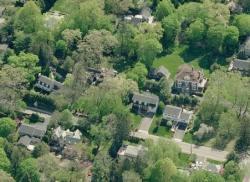Where’s Lawler? Hundreds Attend in-Person Town Hall in Peekskill to Demand Answers of Absentee Congressman
- Details
- Written by Joanne Wallenstein
- Hits: 1433
 Hundreds of constituents filed into Dramatic Hall in Peekskill, N.Y. on Saturday, March 22 to demand answers of Republican Representative Mike Lawler. Hundreds more, unable to fit inside the packed-to-capacity venue, lined the street and snaked around the block. After they were turned away from the indoor town hall, the overflow crowd spontaneously held a rally in the street. Congressman Lawler was a no-show.
Hundreds of constituents filed into Dramatic Hall in Peekskill, N.Y. on Saturday, March 22 to demand answers of Republican Representative Mike Lawler. Hundreds more, unable to fit inside the packed-to-capacity venue, lined the street and snaked around the block. After they were turned away from the indoor town hall, the overflow crowd spontaneously held a rally in the street. Congressman Lawler was a no-show.
The town hall was organized by two women who describe themselves as “two ordinary women who are pissed off.” One of the organizers commented, “Lawler's actions affect us all. He was the deciding vote on the budget bill (which, among other things , decimates Medicaid). In addition to the fact that the proposed budget hurts the most marginalized among us, it threatens the rest of us. For example, if Medicaid is decimated, services at hospitals will be impacted (curtailed), premiums for all of us will go up, and rural hospitals may well be forced to close. Lawler is co-sponsoring the SAVE Act, which the League of Women Voters characterizes as a voter suppression bill. And it is no secret that Lawler hopes to run for governor. (He's been out of the district a lot lately, e.g., on Saturday, he was at a parade in Yonkers, making sure that voters around the State know him.) “
Anticipating that Lawler – who has carefully tried to avoid the mounting outrage and alarm being expressed throughout the district for his support of the MAGA Republican agenda – would fail to attend the in-person town hall, organizers mounted a dummy Mike Lawler on the stage.
In addition to posing questions to the dummy, the organizers crafted responses based on the Congressman’s record. (See one example.)
“Dummy Mike” was asked questions about women’s healthcare decisions and his anti-abortion stance, immigration, the SAVE Act (which he is co-sponsoring and is widely regarded as a voter suppression bill), the dismantling of the Board of Education, and his false and misleading claims that he is a moderate and bipartisan.
Members of the audience addressed these as well as other issues, including Veterans’ services, the budget resolution (in support of which Lawler cast the deciding vote and which necessarily guts Medicaid), crime, safety and security. (Here is the voice of one community member, Melitta Corselli.)
At the conclusion of the town hall, participants wrote messages to Mr. Lawler on neon-colored index cards, which they scattered on and around “Dummy Mike.” These messages will be delivered to Lawler’s Pearl River office on Wednesday, March 26 at 11 am. The details are posted here.
Voters had repeatedly asked Congressman Mike Lawler to hold an in-person town hall during the current congressional recess (March 13 through March 23). He declined to do so. After organizers arranged for this town hall and invited Congressman Lawler to attend, he promptly announced that he was holding a tele-town hall last Wednesday, March 19. There, participants were muted, and Lawler seemingly hand-picked constituents to ask a mere eleven, mostly friendly questions. He avoided answering any challenging questions by simply pivoting to a different answer, and those questioning him were prevented from pressing further.
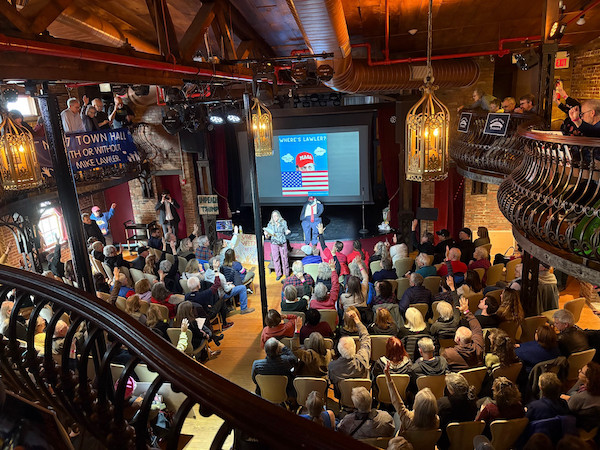
St. James in the 1920s-40s: Growth, War, and the Battle for Belief
- Details
- Written by Joanne Wallenstein
- Hits: 626
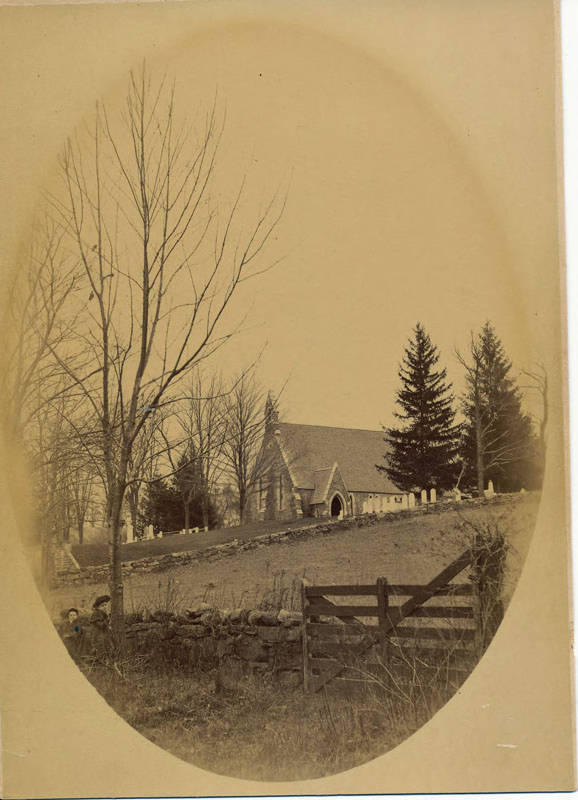 Saint James the Less Church, Scarsdale Public Library - New York Heritage Digital CollectionsSt. James the Less, Episcopal Church, in Scarsdale is celebrating its 175th anniversary. As part of that celebration, the parish has undertaken a lecture series that examines the Church's role and evolution during that period. Here, in a lecture delivered on Sunday March 9, we learn about St. James from 1920-1940, when it was the largest church in Westchester with 800 families and over 2,000 children in Sunday School. With the arrival of the train station, Scarsdale boomed and so did St. James.
Saint James the Less Church, Scarsdale Public Library - New York Heritage Digital CollectionsSt. James the Less, Episcopal Church, in Scarsdale is celebrating its 175th anniversary. As part of that celebration, the parish has undertaken a lecture series that examines the Church's role and evolution during that period. Here, in a lecture delivered on Sunday March 9, we learn about St. James from 1920-1940, when it was the largest church in Westchester with 800 families and over 2,000 children in Sunday School. With the arrival of the train station, Scarsdale boomed and so did St. James.
Here is the history as told by Russell Grant:
A Church on the Hill in Scarsdale 1920s–1940s
St. James the Less, Episcopal Church, is the oldest church in Scarsdale, celebrating its 175th anniversary this year. As the village of Scarsdale grew and transformed over the 20s, 30s, and 40s, so too did St. James, expanding its congregation, its physical footprint, and influence.
Growth and Development in the 1920s
The town’s population surged from approximately 3,500 in 1920 to over 13,000 by 1950, reflecting its rapid transformation into a thriving suburban community. St. James’ membership increased from 190 families in 1920, to nearly 900 families by the early 40s, making it among the largest churches in Westchester County. Under the leadership of its two rectors during these three decades, Alan Chalmers and Harry Price, the church played a significant role in the social and political life of the village.
St. James expanded its physical presence under the architectural design of the eminent architect, Hobart Upjohn, who also designed the Scarsdale Community Baptist Church.
1940s and World War II
The 1940s brought new challenges as World War II reshaped both Scarsdale and St. James. During World War II, many of the church’s members played remarkable roles in the war--380 members of St. James served in the armed forces. Among them were the four siblings of the Compton family. William Compton served on a torpedo boat in the South Pacific, James Compton led a platoon onto Iwo Jima, while Ann Compton was stationed with the Red Cross in Europe. John Parker Compton, was a member of the elite 10th Mountain Division who died in combat in mountains of Italy. Another WW II veteran ‘Scarsdale Jack,’ was a celebrated fighter ace who perished in Thailand. Their valor and sacrifices stand out as extraordinary, though they were typical of a generation where all levels of society leaned into the war effort.
St. James Post-War
St. James was deeply woven into the fabric of the community. Clergy and parishioners were engaged in the ideological battles of the time. Following the war, Assistant Rector William Kernan emerged as a member of the ‘Committee of Ten,’ a part of the ‘Scarsdale Citizens Committee’, which sought to ban books they deemed subversive or sympathetic towards communism, such as works by Howard Fast, the author of Spartacus, as well as Langston Hughes. Their actions reflected the era’s heightened anxieties about Marxist influence in the school curriculum.
In 1948, the Rector, Harry Price and several parishioners protested to the State Department’s decision to grant a travel visa to Hewlett Johnson, the ‘Red Dean of Canterbury,’ a British clergyman known for his pro-Soviet views.
In the early fifties, both Harry Price and William Kernan made national news, including in Time, when they abruptly left the episcopal clergy to convert to Roman Catholicism.
Village Staff Recommends Installing Artificial Turf on Winston Field and Six Pickleball Courts at Crossway
- Details
- Written by Joanne Wallenstein
- Hits: 943
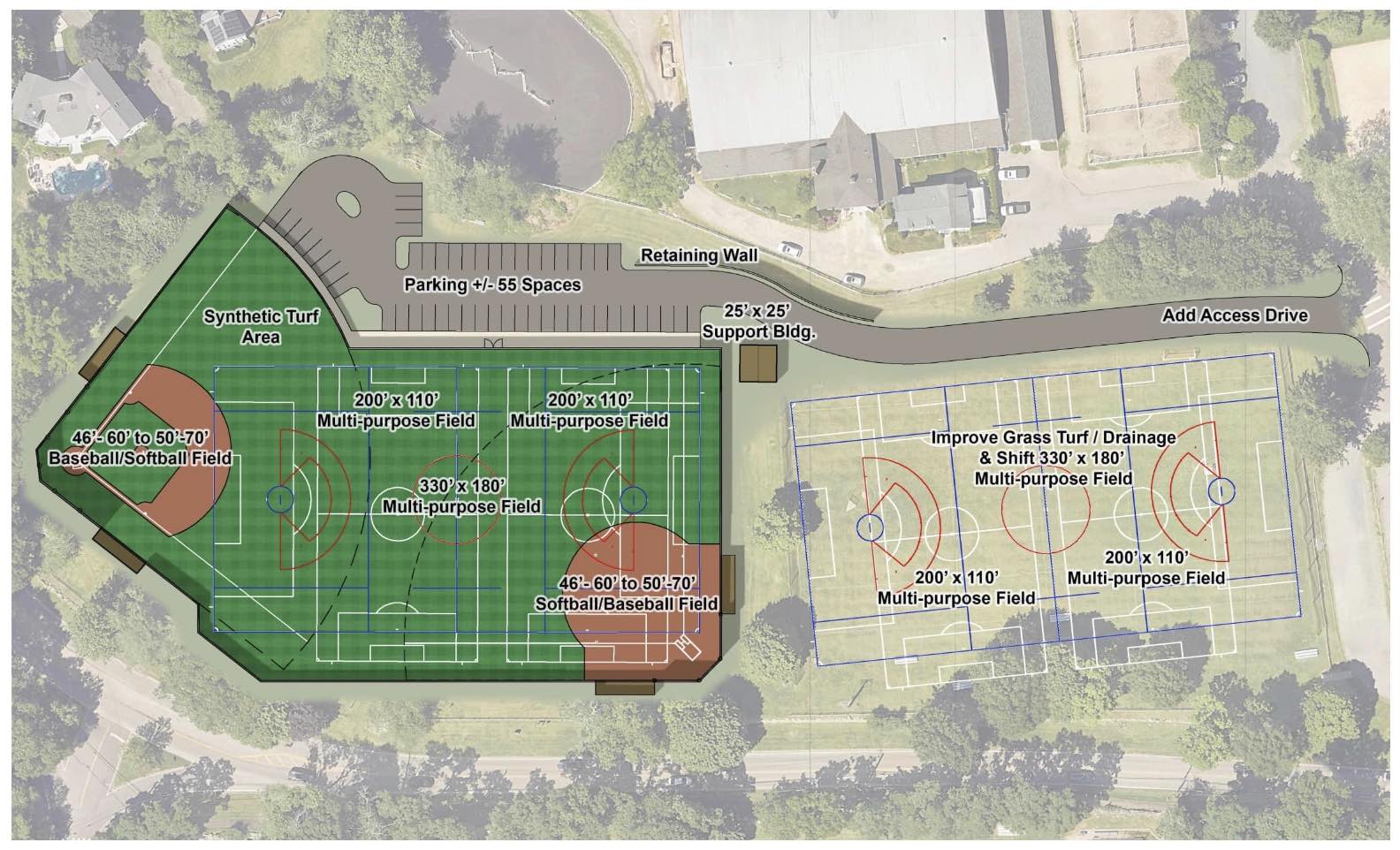 Synthetic turf is proposed at Winston FieldWith the clock running down to finalize the 2025-26 Village Budget, the Village Board held a work session on February 24 to review the staff’s recommendation for improvements to fields and parks.
Synthetic turf is proposed at Winston FieldWith the clock running down to finalize the 2025-26 Village Budget, the Village Board held a work session on February 24 to review the staff’s recommendation for improvements to fields and parks.
Their recommendations were the outcome of a comprehensive athletic field and court study undertaken in cooperation with the Scarsdale Schools. The study included a needs assessment, several public outreach sessions and surveys. You can see the field study here.
At the meeting this week, the Village Board considered improvements to Village owned properties including fields and courts. It will be up to the schools to fund improvements to school facilities.
Village Manager Alex Marshall explained that the cost estimates for the work do not include surveying, soil testing, traffic studies or engineering evaluations, all of which will need to be done as part of the work. Therefore, additional funds have been included in the estimates by Village Staff.
The staff recommendations include one new turf field, improvements to natural grass fields, additional parking and restroom facilities and tennis court repairs. See the presenstation here.
Here are the specifics:
At Boulder Brook and Winston Field, the staff recommends the following:
-An artificial turf and drainage improvements for Winston Field.
-Enhancement of the natural turf at Boulder Brook Field.
-The addition of a support building with restrooms at Boulder Brook Field.
-The addition of new access roadway and parking to improve parking at the two fields.
She explained that the projected design/engineering costs would be $795,000 and the construction estimate for the following year would be $5,320,000.
The rationale for the recommendation is that Winston Field is very wet and often not playable. The turf field would accommodate increased playing time during more months of the year, at times when the natural turf is not usable.
Bathrooms are needed on the Boulder Brook side of Mamaroneck Road so that players do not have to cross the busy road to access facilities. And additional parking is needed for the participants and parents.
Crossway
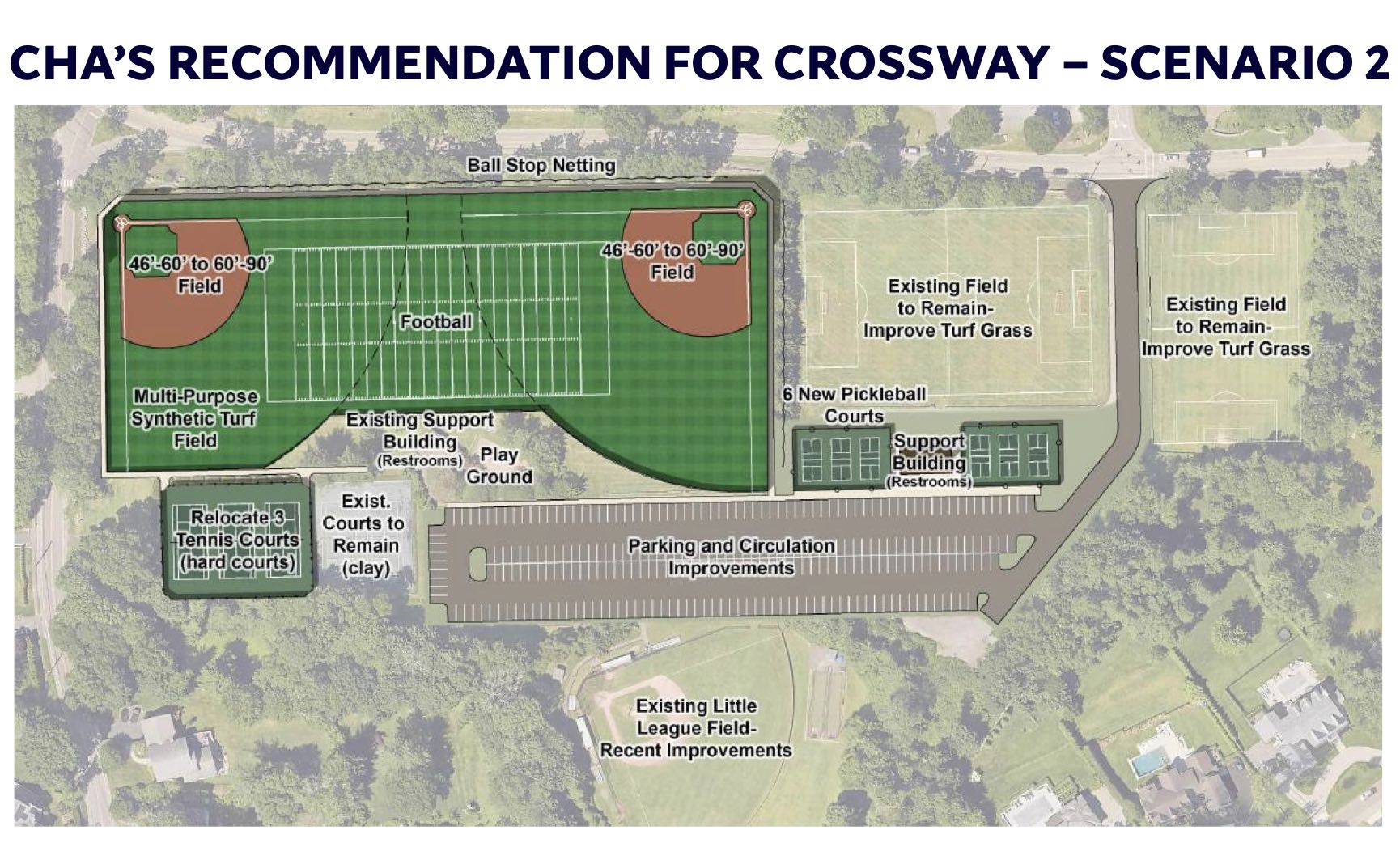 At Crossway, three tennis courts will be relocated and six pickleball courts will be built. Crossway will only have natural turf fields - no artificial turf. This drawing represents the site plan.
At Crossway, three tennis courts will be relocated and six pickleball courts will be built. Crossway will only have natural turf fields - no artificial turf. This drawing represents the site plan.
At Crossway, the staff recommended improvements to the natural turf rather than the construction of more artificial turf. Though the consultants proposed artificial turf at the site, Village staff decided against it.
The recommendation for Crossway includes:
-Six new pickleball courts
-Enhanced parking by re-locating the three existing hard courts to the other side of the Har Tru courts. 268 parking spots are proposed.
-Drainage and grass improvements to the natural fields.
-A new support building with restrooms
-Moving the entry to the complex to Mamaroneck Road.
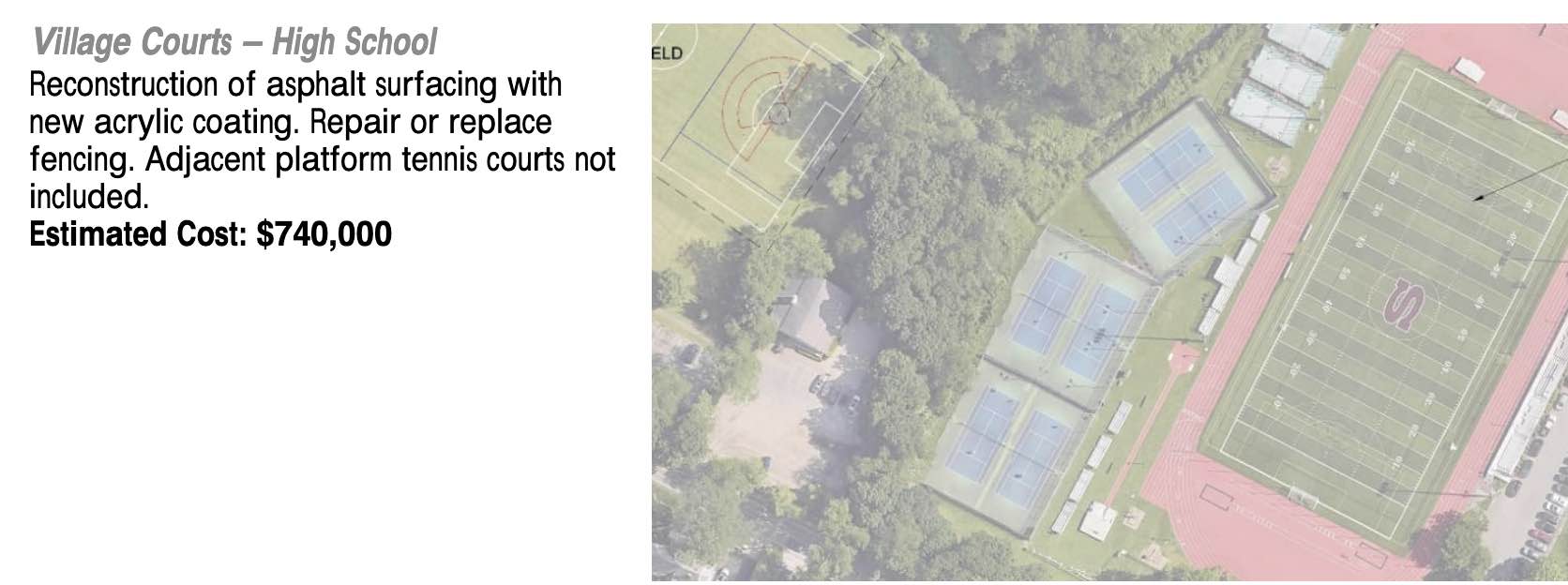
The projected design/engineering costs are $886,500 and the estimated construction costs are $5,910,00.
Also in the recommendation are repairs to the cracks on the tennis courts at Scarsdale Middle School and Scarsdale High School.
The cost to repair the middle school courts is estimated at $140,000 and the high school is $150,000.
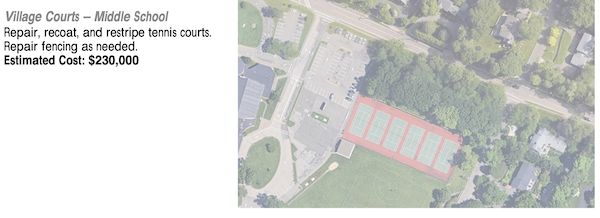
Since these costs for the tennis court repairs are to be split with the schools, Trustees need to determine if the district prefers to resurface the courts, as recommended by the consultants, or to repair the courts as recommended by Village staff.
Trustee Gruenberg questioned why residents can’t use the high school and middle school tennis courts during the school days since the Village is shouldering the cost.
Also slated for the 2025-26 budget is $300,000 for the replacement of the playground at Aspen Park. Superintendent Gray said that when the Village replaced the playground at Greenacres they learned what the actual costs were to build a new playground. Therefore he plans to allot $300,000 per year in the coming years to replace one playground each year.
The Village is analyzing whether these projects should be financed through the General Fund or by issuing bonds.
Though the community has voiced the need for more field time, the Recreation Department has not provided statistics on how much unmet demand would be satisfied by these improvements. Supervisor Brian Gray will ask the consultants for an estimate.
Commenting on the rationale behind the recommendation, Mayor Justin Arest said, “The goal is to balance economics, the environment and to get more playing time.” He added that the Parks and Recreation Council, PRC, is in favor of the artificial turf at Winston Field.
Supervisor Gray also proposed including $120,000 to repair the all weather tennis courts at Crossway that are now being used for pickleball. He said, “The courts are cracked, there are depressions and grass is growing through the cracks. He also said that the acoustafence panels that have been added to block the noise are too much for the fence posts which are now bending.
Mayor Arest pointed out that these three courts are slated to be moved as a part of the Crossway project so he questioned spending $120,000 on courts that will only be used for a few seasons.
During public comments, students Charlie and Max Geer came to the mic. Charlie said that he “loves playing lacrosse and needs durable 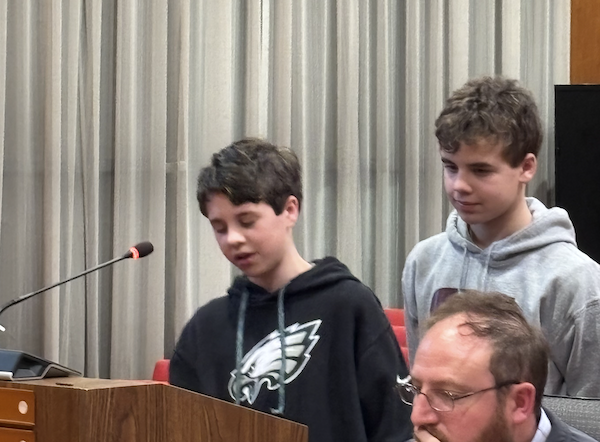 Charlie and Max Geer told the Trustees that more playable fields are needed.fields.” He said, “the fields degrade during the season and turn into mud.” He said, “it’s slippery and players hurt themselves.”
Charlie and Max Geer told the Trustees that more playable fields are needed.fields.” He said, “the fields degrade during the season and turn into mud.” He said, “it’s slippery and players hurt themselves.”
His older brother Max pointed out that the JV lacrosse team can’t plan many months because they can only play on the high school turf. He pointed out that when kids can’t play, they waste time surfing the internet.
Anne Hintermeister asked, “Can we get grants to fund some of this? Or can we get community support for funding? How will these costs impact the budget?”
Mayor Arest responded, saying, “We will take care of all grant opportunities. We have heard that Maroon and White and the ISO’s might be willing to raise funds to help. We are going to include a budget line of $2 mm in gifts to offset the construction costs.”
Ralph Geer who heads the youth lacrosse ISO stressed the need for more playable fields. He said, “We struggle to find field time. We have a subcommittee devoted to this. We rent space at the Underdome in Pelham as there is not enough space here. Anything we can do to alleviate the demand would be tremendous.” He added, “I also play in a men’s adult lacrosse team.
We have asked for field time but cannot get any so we have to play at 7 am in the morning.”
Eugenie Rosenthal called in and said, “Is the Weinberg Nature Center being considered as a part of this discussion – or is that a separate discussion?
Mayor Arest said, “I don’t think there are plans for the Weinberg Nature for this budget. More work needs to be done and perhaps funds can be put in for future years.”
Moira Crouch, President of Maroon and White, also called in. She refuted the idea that Maroon and White would help to fund renovations of Village owned fields. She said, “We focus on school district owned properties. We don’t have control over Winston Field.”
Trustee Wise asked the Village to also provide cost estimates for natural turf instead of artificial turf and to look at alternative materials for the artificial turf. He said, “They are not all the same.”
The Mayor said, “Based on our needs, I don’t think all natural turf will meet the needs of the community.”
He continued, “Recycled crumb rubber is a concern. We can look at virgin crumb rubber. There are other materials and new technologies, solutions to the heat that comes off the field. There are tradeoffs – we are not turfing all of our fields, just Winston, and we will get a very usable field and minimize those risks.”
A Timely New Novel from Scarsdale's Jacqueline Friedland
- Details
- Written by Joanne Wallenstein
- Hits: 974
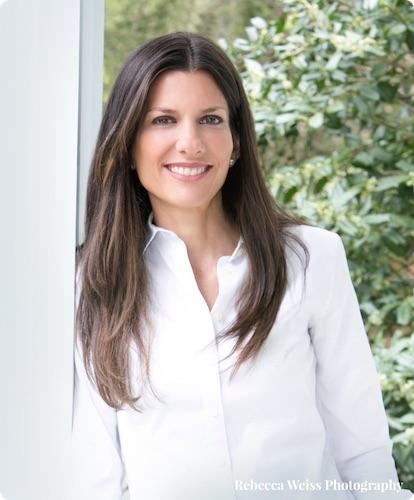 Scarsdale resident Jackie Friedland will release her fifth novel this week. Counting Backwards focuses on female immigrants and their reproductive rights and is published by Harper Muse, an imprint of Harper Collins.
Scarsdale resident Jackie Friedland will release her fifth novel this week. Counting Backwards focuses on female immigrants and their reproductive rights and is published by Harper Muse, an imprint of Harper Collins.
Here’s a description of a book that spans a century:
A routine immigration case, a shocking legacy. Jessa Gidney's quest for justice draws her into the heart of an abhorrent conspiracy. As she uncovers her personal ties to a heartbreaking past, her life takes a dramatic turn, in this emotionally riveting novel inspired by true events.
New York, 2022. Jessa Gidney is trying to have it all--a high-powered legal career, a meaningful marriage, and hopefully, one day, a child. But when her professional ambitions come up short and Jessa finds herself at a turning point, she leans into her family's history of activism by taking on pro bono work at a nearby ICE detention center. There she meets Isobel Pérez--a young mother fighting to stay with her daughter--but as she gets to know Isobel, an unsettling revelation about Isobel's health leads Jessa to uncover a horrifying pattern of medical malpractice within the detention facility. One that shockingly has ties to her own family.
Virginia, 1927. Carrie Buck is an ordinary young woman in the center of an extraordinary legal battle at the forefront of  the American eugenics conversation. From a poor family, she was only six years old when she first became a ward of the state. Uneducated and without any support, she spends her youth dreaming about a different future--one separate from her exploitative foster family--unknowing of the ripples her small, country life will have on an entire nation.
the American eugenics conversation. From a poor family, she was only six years old when she first became a ward of the state. Uneducated and without any support, she spends her youth dreaming about a different future--one separate from her exploitative foster family--unknowing of the ripples her small, country life will have on an entire nation.
As Jessa works to assemble a case against the prison and the crimes she believes are being committed there, she discovers the landmark Supreme Court case involving Carrie Buck. Her connection to the case, however, is deeper and much more personal than she ever knew--sending her down new paths that will leave her forever changed and determined to fight for these women, no matter the cost.
Alternating between the past and present, and deftly tackling timely-yet-timeless issues such as reproductive rights, incarceration, and society's expectations of women and mothers, Counting Backwards is a compelling reminder that progress is rarely a straight line and always hard-won. A moving story of two remarkable women that you'll remember for years to come.
Kelly Rimmer, bestselling author of The German Wife said this about Counting Backwards ... a riveting, compelling story--but it's also an important one, reminding us that history's darkest aspects can echo forward into our present day and that there is so much work left to do in the fight for freedom and equality."
Buy your copy from Scarsdale’s Bronx River Books here.
ISO Presidents Write in Support Artificial Turf
- Details
- Written by Joanne Wallenstein
- Hits: 861
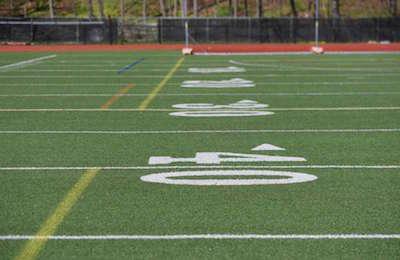 (The following letter was written by the Presidents of Scarsdale's Independent Sports Organizations)
(The following letter was written by the Presidents of Scarsdale's Independent Sports Organizations)
Dear Mayor Arest, Superintendant Patrick, Village Officials, Board of Education Members, and Village Trustees,
We strongly support expanding field uptime and improving facility quality by implementing synthetic turf and strategic field enhancements. The recent joint field study by the village and Board of Education CHA report provides a well-researched roadmap for ensuring consistent and equitable access to high-quality recreational facilities for Scarsdale’s youth athletes, families, and community members.
As the demand for athletic field space increases and an increasing volume of weather events that limit field uptime, Scarsdale must take actionable steps to modernize its sports infrastructure. To maximize usability, safety, and accessibility, synthetic turf must be incorporated where appropriate and improve natural field conditions.
The Critical Need for More Field Space
As recognized by Scarsdale’s Independent Sports Organizations (ISOs), the demand for athletic field space has continued to grow due to increasing youth participation in sports such as soccer, lacrosse, baseball, softball, and basketball. Our existing grass fields and facilities alone cannot sustain the high demand, particularly given seasonal weather limitations and wear-and-tear issues. This results in:
● Reduced playing time for youth athletes due to the limited durability of natural grass fields.
● More frequent game and practice cancellations due to rain, leading to inconsistent seasons.
● Overuse of existing natural grass fields, making them unsafe and unplayable for extended periods.
● Increased costs for field maintenance to maintain playable conditions on natural grass fields.
● Fewer teams and sports options: Children have fewer opportunities to participate in organized sports, impacting physical health and social development.
The Benefits of Artificial Turf Fields
When properly installed and maintained, modern synthetic turf fields offer a safe, durable, and environmentally sustainable alternative to grass fields. Research and real-world implementation have demonstrated several benefits:
● Increased playability & extended Seasons: synthetic turf can be used year-round, ensuring children have consistent outdoor recreation access.
● Durability: Synthetic fields can accommodate more hours of play without excessive wear and tear, reducing the long-term maintenance costs associated with natural grass.
● Safety Improvements: advances in synthetic turf technology, including shock-absorbing infill and cooling systems, have reduced injury risks and mitigated concerns about surface heat.
● Environmental Benefits: Unlike natural grass, artificial turf eliminates the need for pesticides, fertilizers, and excessive water usage. Many modern turf systems also include recyclable materials and environmentally friendly disposal programs.
The Broader Benefits of Expanding Field Access
Providing safe, reliable access to sports fields has well-documented physical, mental, academic, and social benefits for children and adolescents. Research supports the need for increased playability, especially in youth sports settings:
1. Physical Health Benefits
● Increased Physical Activity Levels: Children with access to high-quality sports fields are significantly more likely to engage in regular physical activity, reducing the risk of obesity, diabetes, and cardiovascular diseases.
● Reduced Sedentary Behaviors: Increased access to sports facilities reduces screen time and sedentary habits, contributing to long-term health issues.
2. Mental Health and Emotional Well-Being
● Reduction in Stress and Anxiety: Sports participation helps lower stress levels, reduces anxiety, and improves overall mental well-being in young athletes.
● Improved Self-Esteem: Youth sports build confidence, teamwork, and leadership skills, helping children develop lifelong interpersonal strengths.
3. Academic and Cognitive Benefits
● Better Academic Performance: Research links physical activity to improved cognitive function, memory, and focus, resulting in stronger academic performance.
● Time Management and Discipline: Structured sports participation fosters essential skills such as discipline, goal-setting, and resilience.
4. Social and Community Benefits
● Social Skill Development: Sports participation fosters teamwork, cooperation, and positive peer interactions.
● Increased Community Engagement: Recreational sports facilities are vital community hubs, fostering inclusivity and engagement across socio-economic groups.
A Balanced Approach
Scarsdale should consider a balanced, evidence-based approach supporting youth sports participation and environmental responsibility. We propose the following actions:
-Implement simple standards for synthetic turf and natural grass field design.
-Enhance maintenance and scheduling for natural grass fields to maximize their usability and longevity.
-Conduct periodic field safety to ensure they meet the established standards.
-Engage in community dialogue with ISOs and parents to ensure that decisions reflect the needs of Scarsdale’s children and families.
-Ensuring That Scarsdale’s Children Have Access to High-Quality Sports Facilities
-Limited field access due to weather and field quality disproportionately harms young athletes and their families, reducing opportunities for organized sports and healthy recreation.
We urge the Mayor, Village Board, Board of Education, and community stakeholders to prioritize expanding field access instead of restricting it. Investment in artificial turf and improved field design will ensure that Scarsdale becomes a leader in youth sports and community wellness.
Thank you for your time and consideration,
Scarsdale Independent Sport Organizations
Tom Groark & Nicole Dubbs, Scarsdale Little League
Dave Brown, Scarsdale Youth Basketball, Inc.
Kristy Grippi & Josh Horowitz, Scarsdale Youth Lacrosse Association
Eric Premisler, Scarsdale Youth Soccer Club
Joe Guarino, Scarsdale Travel Softball
Richard “Rippy” Philipps, Scarsdale Youth Football














